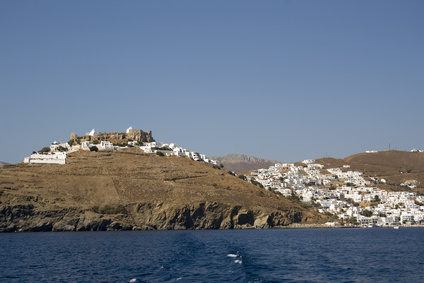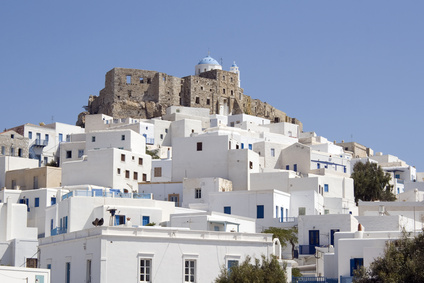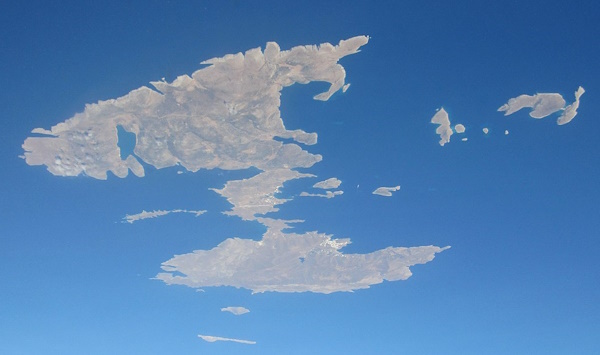Astypalea (area just under 100 km²) is the westernmost of the Dodecanese islands. Geographically, it lies between the Dodecanese and the Cyclades. Tourism on Astypalea is hardly developed, as the island is off the main ferry routes. Life on Astypalea is therefore much more traditional than on other islands, which makes a visit interesting. Other spelling: Astipalea
Many of the 1,200 inhabitants of Astypalea are in a good mood and always open to a conversation. They are even interested in the few strangers who visit their Astypalea. The unusual shape of Astypalea has earned the island the nickname Butterfly Island. Two larger parts of the island are connected by a land bridge.
 Image: tella0303 – Fotolia.com
Image: tella0303 – Fotolia.com
Skala and Hora: The largest settlement on the island consists of Skala and Hora. Around 80% of all the island’s inhabitants live here. This is where the ferry port, most of the accommodation, taverns and tourists are located. The small local museum and the castle above the town are worth seeing. The Venetian castle of Astypalea dates back to the 13th century.
 Image: tella0303 – Fotolia.com
Image: tella0303 – Fotolia.com
Outside the main town, there is a tourist attraction on Astypalea near the village of Maltezana. It is a Roman bath with well-preserved, beautiful mosaics. The beaches on Astipalea are not exactly positive for the development of tourism on the island. Apart from a few smaller pebble beaches, there is not much.
 By INDALOMANIA, CC BY-SA 3.0, https://commons.wikimedia.org/w/index.php?curid=54856123. The shape of the island of Astypalea is reminiscent of a butterfly
By INDALOMANIA, CC BY-SA 3.0, https://commons.wikimedia.org/w/index.php?curid=54856123. The shape of the island of Astypalea is reminiscent of a butterfly
Prices are fairly low. In the small cafes, it is easy to strike up a conversation with the locals, especially if you have a common language (English is not very common). Beautiful and quiet beaches can be found about a 15-minute walk away. Rooms can be a little scarce in July and August, but the rest of the year it is easy to find accommodation on Astypalea.
As there are few roads, hiking is particularly interesting. Many paths lead to remote parts of the island. Locals are happy to help plan hikes. A bus runs a few times a day to the small settlements on Astypalea, which are connected by a paved road.
Ferries to Astypalea: A trip to Astypalea must be carefully planned as there are only a few ferry connections. There are about 2-3 ferries per week from Athens, Naxos and Paros. There are also ships going in the opposite direction to Kalymnos, Kos and Rhodes. Many of the ferries arrive in Astypalea in the middle of the night or leave in the middle of the night. Astypalea is just a short stopover for the large ferries, most of which are from Blue Star. There is a small airport. However, flights from Athens to Astypalea and back are often fully booked. Kos: About 3-4 hours by ferry. Rhodes: About 6-7 hours by ferry.
➔ To book ferries within Greece, we recommend the reputable website Ferryscanner.com
Flights to Astypalea: Astypalaia Island National Airport is small and mainly offers domestic flights. Especially in high season (May to October) there are flights from major cities in Greece, such as Athens and Thessaloniki.
Accommodation Astypalea: Even on a small island as little visited by tourists as Astypalea, there are now around 80 houses offering rooms or apartments. Almost all of them are listed on Booking.com. The majority are in the main town and port of Skala. The Vithos Seaside Aparthotel right by the port is inexpensive and our favorite.
Hiking Astypalea
Astypalea, a beautiful island, offers stunning landscapes and various hiking trails. There are few paved roads, which makes hiking particularly attractive. Here are some popular hiking routes and tips for exploring the island:
Chora to Livadi Beach: This moderately difficult trail leads from the main town of Chora down to the picturesque Livadi Beach with stunning sea views.
Chora to the Old Windmills: A short hike that takes you to the old windmills where you can enjoy panoramic views of the island.
Paleo Chorio (Old Village) Trail: This trail leads to the ruins of the old village, surrounded by wildflowers and with great views.
Castle: Hike up to the castle for a mix of history and stunning views. The trail can be steep but rewards you with picturesque scenery.
Spring (April to June) and early autumn (September to October) are ideal for hiking due to the milder weather. Always bring plenty of drinking water! Wear sturdy walking shoes as some trails can be rocky.
Getting around Astypalea
Buses connect the capital Chora with several beaches, villages and other important points on the island, such as Livadi beach, Agios Konstantinos and the old village of Paleochora. Schedules: Buses usually run several times a day, but the frequency may decrease in the off-season. Tickets are available from the driver (cheap).
Renting a vehicle: This is also possible in Chora: mopeds (scooters). Bicycles and cars. Since many of the roads in Astypalea are unpaved and mountainous, a suitable vehicle (jeep, mountain bike or e-bike, motorcycle for off-road use) is recommended.
There are also a few taxis on the island.
Boat tours Astypalea: In Chora, boat trips are offered to various remote beaches and small islands such as Koutsomitis and Kounoupes.
Map
|
The map clearly shows the unusual shape of the island, which is vaguely reminiscent of a butterfly. The small airport is in the middle. There are many well-protected bays. |
Astypalea Insel ( ![]() German version)
German version)
Do you have any feedback, additions, found an error or a comment? Send us an email to: mail@griechenland-insel.de